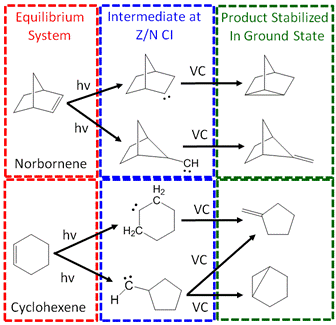Reports: ND653676-ND6: Ultrafast Photochemical Reactions in Cyclic Monoalkenes
Andrew M. Moran, University of North Carolina
I. Overview
The goal of this project is to use newly developed sources of femtosecond deep ultraviolet laser pulses to study mechanisms of elementary chemical reactions. In recent years, our group has developed methods for generating sub-100-fs ultraviolet laser pulses at 200 nm using nonlinear processes in noble gases. Light at 200 nm is required to initiate ring opening reactions in cyclic monoalkenes such as cyclohexene and norbornene (see Figure 1). Studies of such elementary reactions may yield insights into the mechanisms at work in combustion processes.
Figure 1. Dominant reaction pathways for norbornene (top) and cyclohexene (bottom). Dynamics are initiated by photoexciting the equilibrium system at 200 nm. Sub-picosecond relaxation to the ground state by way of a sequence of conical intersections. At the conical intersections, the systems are in the intermediate states indicated in the middle panel. Vibrational cooling in the ground electronic state stabilizes the final products shown on the right; these dynamics span the picosecond to 10's of picoseconds time scales.
II. Progress to Date
IIA. Ultrafast Dynamics in Norbornene and Cylcohexene
The experiments conducted in this project aim to understand the ring opening mechanisms in cylcohexene and norbornene (see Figure 1). To this end, femtosecond pump-probe experiments have been conducted with 200-nm laser pulses. Femtosecond laser spectroscopies are challenged by undesired photoionization processes and dispersion management in this wavelength range. Photoionization processes must be suppressed by keeping the laser fluence very low, which makes the signals small. In addition, the polarizability response of the solvent dominates the signal when the pump and probe pulse are overlapped, thereby obscuring information about internal conversion at pulse width limited delay times (less than 200 fs in our setup). For this reason, extremely short lasers pulses must be employed to resolve the internal conversion dynamics in these systems. To date, we have succeeded in detecting the vibrational cooling dynamics that take place subsequent to internal conversion in both cyclohexene and norbornene (see Figure 2).
Figure 2. Transient absorption data obtained with 200-nm pump and probe pulses for (a) cyclohexene and (b) norbornene in cyclohexane solvent. (c) The comparison of fits obtained for the two systems suggests that internal conversion-induced vibrational cooling is faster in norbornene than it is in cyclohexene. Future work will attempt to improve the time resolution of this apparatus and obtain better information about the internal conversion mechanisms.
IIB. Photodissociation of Triiodide
The setup we developed for generating the 200-nm laser
pulses also yields high-energy 267-nm laser pulses. These 267-nm pulses were
used to study the photodissociation reaction of triiodide with a new
experimental method, two-dimensional resonance Raman (2DRR) spectroscopy. 2DRR
spectroscopy yields insights into chemical reactions that cannot obtained using
conventional time-resolved approaches. With acknowledgment of ACS PRF support,
two applications of 2DRR spectroscopy were published in the Journal of Chemical
Physics in 2014-2015. One of these articles was received the honor of an
Editor's choice for 2014 (Molesky et al. J. Chem. Phys. 141, 114202, (2014)).
When photoexcited in the UV
spectral range, triiodide dissociates into diiodide and iodine. The reaction is
faster than the 300-fs period of the bond stretching motions in both triiodide
and diiodide. Therefore, the diidodide product exhibits coherent vibrational
motions which can be detected with a sequence femtosecond laser pulses. Figure 2
shows that particular 2DRR pulse configurations can be used to view
correlations between coherent motions of the reactant and product in ultrafast
chemical reactions.
IIC. Photodissociation of Oxygen in Myoglobin The 2DRR experimental setup
constructed for studies of photochemical dynamics can also be used to study
chemical reactions in complex system. The key is that the vibrational
resonances of the system are displayed in two dimensions, so the spectra are
less congested than a conventional one-dimensional Raman spectrum. We have
demonstrated the potential of the 2DRR approach in an application to oxygen
photodissociation in myoglobin. In Figure 4, the vibrational resonances of the
heme are displayed for both metmyoglobin (metMb) and oxymyoglobin (MbO2).
The vibrational line shapes provide information about heterogeneity in the
structure of the heme within the ensemble.
Figure
4. (a)
Structure of the heme cofactor. 2DRR spectra are acquired for (b) metMb and (c)
MbO2. Cross peaks are indicated with arrows. Adapted from Molesky et
al. J. Chem. Phys. 145, 034203 (2016). III. Impact of ACS-PRF Support on Personnel Support of ACS-PRF has
facilitated the development of 2DRR spectroscopy. In 2016, we have been invited
to write a review article about 2DRR spectroscopy by the Journal of Chemical
Physics and a book chapter. Such recognition will have a positive impact on the
careers of the PI and students. Two graduate students and one undergraduate
worked on this project. One graduate student who was supported by ACS-PRF funds,
Brian Molesky, was hired as an ultrafast laser engineer by Coherent in the
summer of 2016. An undergraduate, Andrew Ross, graduated in the spring of 2016
and is now a graduate student at the University of California at Berkeley.
IV. Future Directions In summary, we have successfully
resolved the vibrational cooling dynamics that take place subsequent to
internal conversion in both cyclohexene and norbornene. Differences in the
vibrational cooling rates reflect structure-dependent redistribution of vibrational
quanta. A new laser system was installed in our laboratory in the spring of
2016. Compared to our previous system, this new laser is more powerful and
produces shorter pulses. We now have the resources needed to produce powerful
pulses in the deep UV region of the spectrum. Our plan is to use the newly
developed 2DRR method described in Section IIB to explore correlations between
reactants and products in elementary ring-opening reactions.















